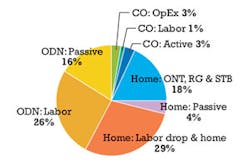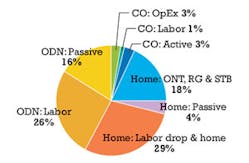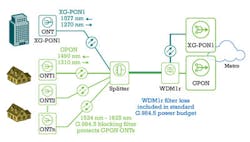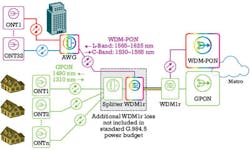Carriers must consider tomorrow's requirements when planning today's broadband access networks.
By MICHAEL GRONOVIUS
Who could have predicted that when we installed the first telephone lines for plain old telephone services decades ago, these same copper pairs would be used for high-speed Internet access? This same scenario needs to be at the top of our mind when deploying today's fiber access networks, as it's highly likely they will need to support technological innovations that have not yet been developed.
We don't precisely know what the future will bring, but we can certainly prepare for it. The Internet has changed dramatically in the last few years. We've gone from web browsing to video streaming. New over-the-top services such as high-definition cloud gaming continue to drive the need for more speed. By 2020, it is estimated that there will be 50 billion connected devices using the fixed and mobile broadband network. This will create the networked society, in which everything benefiting from a connection will have one. In fact, Nielsen's law predicts that a high-end user's connection speed grows by 50 percent per year. This means that a subscriber enjoying a 20-Mbps service today will want 152 Mbps by the year 2016.
It's clear that high-speed broadband is critical for the networked society, but how can fixed access networks lead us to this connected future?
Current access technologies
First, let's examine the current generation of access technologies. Operators have two options to offer faster connection speeds: Maximize the use of the existing copper plant or install a new fiber plant. The faster the speed over copper, the shorter the copper loop length has to become, thus driving fiber deeper into the network. This reality gives rise to a new generation of small fiber-fed nodes with VDSL2 in the last thousand feet or few hundred meters. The latest copper advancements such as vectoring enable you to combine multiple VDSL2 pairs to exceed 100-Mbps speeds.
Ultimately, however, fiber will directly connect all users. The decision to deploy fiber rests on a business case evaluation that takes into account factors such as (future) service requirements, investment deferral, total investment, time-to-market, operational expenditures (opex), and many others.
For high-density areas with thousands of homes per node, GPON offers the most economical technology for triple-play services. GPON provides 2.5-Gbps downstream and 1.2-Gbps upstream bandwidth, which can be shared with up to 64 users. The biggest advantage is the ability to share an IPTV channel line-up across all users, making it a very cost-effective technology.
For low-density areas with a few hundred homes per node, Ethernet point-to-point (P2P) can economically offer 100-Mbps or even 1-Gbps symmetrical services. For fiber-to-the-home (FTTH) both GPON and P2P can provide the required bandwidth for residential triple-play services for many years to come.
FTTx network costs
Before looking into the various next-generation access options, we need to understand how investments are made in an FTTH network.
Figure 1 shows the cost components of a typical FTTH network. The central office (CO) costs include the optical line terminal (OLT) costs per subscriber, labor costs, and such other elements as real estate, power, and cooling. Next is the largest portion of the costs - the optical distribution network (ODN), which is the fiber network between the CO and the subscriber. These costs include the fibers, splitters, and labor, of which labor cost is the largest component. The use of micro-ducts with blown fiber will help reduce this labor cost. The final costs come from the drop cable, labor in the house for the home network, the optical network terminal, residential gateway, and set-top box.
The electronics, consisting of the GPON OLT and the optical network terminal (ONT), are only 10 to 15 percent of the total cost of connecting an FTTH subscriber. On the other hand, the ODN plus home network and labor account for roughly 75 percent of the total network investment. Thus, when building an ODN, service providers should ensure it can support both current and next-generation access technologies.
Next-Generation PON
Next-generation PONs support faster subscriber speeds either by increasing the shared bandwidth across multiple users (XG-PON1) or by providing dedicated wavelengths to each individual user (WDM-PON). Initially, next-generation PON will focus on a few targeted applications before reaching mass adoption.
XG-PON1, defined by the ITU-T G.987 series of standards as an NG-PON1 approach for nearer-term deployment, operates with existing ODNs and equipment. It provides a shared 10-Gbps downstream bandwidth, combined with a 2.5-Gbps upstream bandwidth. Deployment initially will focus on fiber-to-the-building (FTTB) applications where hundreds of subscribers may share the same PON.
WDM-PON is a NG-PON2 technology that requires a few enhancements to the ODN for its operation. It provides users logical point-to-point symmetrical bandwidth over a physical point-to-multipoint infrastructure.
A "remote-seeded" approach enables mass deployment of WDM-PON via colorless ONTs. These ONTs adapt automatically to each wavelength without requiring different lasers per wavelength, which significantly reduces operational expenses. In the downstream direction, in addition to the downstream data signals, the OLT sends a broad light source to seed the ONTs. An arrayed waveguide grating filter (AWG) slices the broad light source spectrum into different wavelengths for each subscriber. The ONT in turn locks automatically to the incoming wavelength and uses that same wavelength to transmit in the upstream direction.
WDM-PON is ideal for large enterprise and LTE mobile backhaul applications. It also provides a longer reach than convention PONs, which enables carriers to consolidate the number of central offices.
Careful planning of the optical spectrum enables next-generation PONs to coexist with current GPON in the same fiber as shown in Figure 2. This means operators can maximize their investment in the current ODN. Let's look at how this would work in a pair of scenarios.
XG-PON1 with GPON scenario: In this scenario a new 200-unit apartment high-rise complex is added in a residential neighborhood that uses FTTH with GPON. As there are no spare fibers available in the feeder cable, XG-PON1 can be used to feed the various multi-dwelling ONTs (see Figure 3).
Existing GPON ONTs have an integrated blocking filter (1524 nm to 1625 nm) to protect them from the new XG-PON1 downstream signals - so there is no need to touch any of the existing GPON ONTs. The XG-PON1 signal can be combined with the existing GPON signal via a WDM1r filter. The additional loss for the WDM1r filter is already included for the loss calculation as defined in G.984.5 (1.0 dB for the XG-PON1 path and 0.8 dB for the GPON path). The downstream fiber now contains both the GPON and the XG-PON1 signals. The new XG-PON1 ONTs can be plugged into any free port of the existing power splitter.
WDM-PON with GPON scenario: In this scenario, a new business building is added in a residential neighborhood that uses FTTH with GPON. Similar to the XG-PON1 scenario, the WDM1r filter can separate the GPON and WDM-PON signals in the central office (see Figure 4).
WDM-PON can coexist in the same feeder fiber with GPON, but we need an additional WDM1r filter in the fiber node to separate the GPON and WDM-PON distribution networks. Instead of a power splitter, WDM-PON uses the AWG filter to separate the different wavelengths going to each subscriber. In the upstream direction it uses the C-Band in the conventional ITU-T G.694.1 grid assignments. The downstream signal, meanwhile, uses the L-Band with cyclically related grid assignments as per G.984.6, Amendment 1.
Making the connection
For fiber to the home, GPON and P2P can provide the necessary bandwidth for many years to come. Meanwhile, operators can invest in deep fiber access networks with the knowledge that next-generation PONs will be able to coexist with today's GPON networks. XG-PON1 will initially focus on fiber to the building for high-density multi-dwelling deployments, while WDM-PON deployments will focus on large enterprises, LTE mobile backhaul, and central office consolidation.
With mass-adoption, costs will decrease and make these technologies also suitable for future residential fiber-to-the-home deployments. As a result, we will take another step closer to becoming a truly connected society.
MICHAEL GRONOVIUS is director of IP edge & broadband access product marketing at Ericsson.




